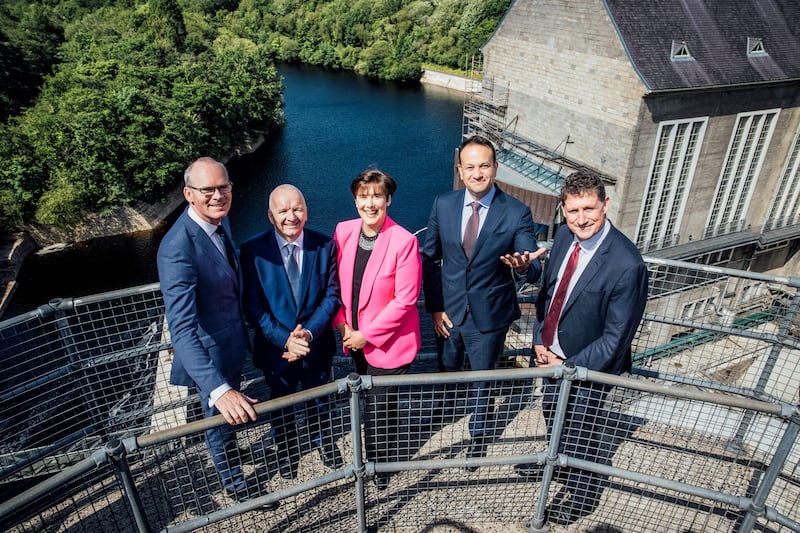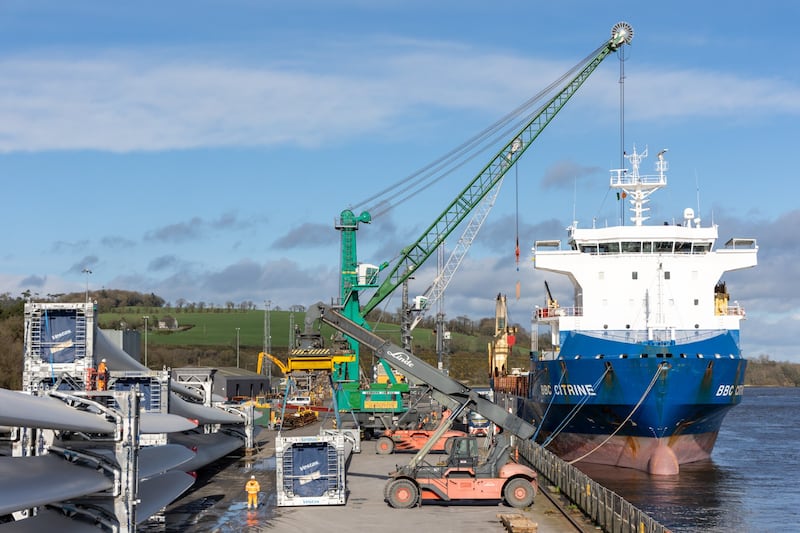At one level, there is a frenzy of activity as onshore renewable energy (wind and solar) and offshore wind developments are being pursued in Ireland. A tight deadline of 2030 is driving this, because of ambitious climate targets committed to by the Government – with the EU pushing hard for delivery.
At another level, there are obvious blockages to progress. For many reasons, offshore renewables is most challenging. But the Government’s new industrial policy for offshore wind and opening of consultation on the Offshore Renewable Energy (ORE) Future Framework Policy Statement is sending the right signals to big international wind developers and investors.
The latter is the long-term vision for offshore renewables in Ireland, setting out a pathway to deliver 20 gigawatts (GW) of offshore wind by 2040 and at least 37GW in total by 2050. Given 1GW can power a city of one million people, the scale of ambition is clear.
Wind energy is central to Ireland and Europe’s decarbonisation and economic plans and is potentially the largest domestic source of electricity that can replace volatile, imported fossil fuels. But, in the Irish context, there is one critical enabler yet to be delivered; adequate port capacity to facilitate offshore windfarms (with fixed-bottom turbines near shore and floating turbines further out to sea).
‘A gas emergency would quickly turn into an electricity emergency. It is low-risk, but high-consequence’
How LEO Digital for Business is helping to boost small business competitiveness
‘I have to believe that this situation is not forever’: stress mounts in homeless parents and children living in claustrophobic one-room accommodation
Unlocking the potential of your small business
They are needed for the assembly and putting in place of turbines and to act as operations and maintenance ports once they are operational. Such is the vast scale of wind resources off our coasts, some ports are likely to act as hubs for green hydrogen production, as excess power generated offshore will be converted to this clean fuel, which is likely to be exported to Europe.
At present, Belfast is the only port sufficiently developed to fulfil this role, though many ports around the entire coastline will be needed. An evaluation of development plans of most major ports in the Republic indicates their offshore priorities, but few are at the level of actually putting in facilities at the level needed with reasonable chance of being fully operational by decade end.
With the largest wind resource in Europe off our west coast and the necessary deepwater in the Shannon Estuary required for facilitating offshore wind at this unprecedented scale, we are staring at an opportunity here that every other region in Europe, not to mind beyond, would crave
Midlands-North-West MEP Colm Markey (FG) believes Ireland cannot achieve energy security and stable energy costs, unless there is a scale-up in renewables – particularly offshore. “When it comes to the roll-out of offshore wind development . . . there are too many bottlenecks with no plan to address them. Our ambition is not matched with delivery, and a major rethink is needed.”
“It’s imperative that the EU and the Irish Government invest in Ireland’s port infrastructure,” he adds – one of five key actions including designation of “renewable acceleration areas” where planning consents can be expedited; expanded grid capacity, investment in skills and training and addressing supply chain issues by building-up “local production”, ensuring access to a range of raw materials.
He welcomes moves at EU level to change criteria for supporting port development, which in the past was based on tonnage and facilitated the fossil fuel sector. Switching to supports based on port services should be adopted, he adds.
Bigger ports such as Shannon Foynes, Belfast and Rosslare will be central to the “build out phase”, while smaller ports will have significant opportunities with operations and maintenance, Markey says.
“Ports such as Drogheda, Bremore, Galway and others across the country will have a vital role to play in facilitating development of renewable energy by offering service hubs, turbine construction sites and green hydrogen production.”
With Dublin at capacity, he recognises the need for new port facilities north and south of the capital.
Ireland’s largest bulk port Shannon Foynes is among the front runners for expansion because of the scale of its ambition; its natural attributes – notably deepwater – and plans tied into a regional transformation, including Limerick city and the Midwest. A pathway for this to happen has been drawn up in a report by the Shannon Estuary Economic Taskforce.
At its launch last year, taskforce chairman Barry O’Sullivan said its impact could potentially stretch from Donegal to Cork and further inland, as the estuary can become “the green digital powerhouse for the country”, by not only delivering unprecedented benefit to the State in terms of sustainable power, but also being “the 21st-century draw for FDI and indigenous business growth”.

A key recommendation was a proposal to create a “national floating offshore wind development agency”; a one-stop-shop to oversee delivery.
Then taoiseach Leo Varadkar said it was visionary and acknowledged the region’s potential as a leader in “building new industries, producing green fertiliser, producing sustainable aviation fuels, powering the nation and also creating power for exports”.
Minister for Energy Eamon Ryan said: “The estuary has the capacity to rebalance the national economy and be an answer to climate change.”
The ESB’s plans for its facilities at Moneypoint in the estuary, by pivoting away from fossil fuels and scaling up offshore renewables, complement what is envisaged.
Since then, Shannon Foynes and Rotterdam port have signed an agreement with a view to developing a supply-chain corridor for exporting green fuels into Europe.
The EU’s 2030 green hydrogen strategy is to import 10 million tonnes of renewable hydrogen for use in heavy industry and transport sectors traditionally reliant on coal, natural gas and oil. Rotterdam intends to facilitate 40 million tonnes from across the world by 2050, a significant proportion of which, it says, can come from the Atlantic resource.
“With the largest wind resource in Europe off our west coast and the necessary deepwater in the Shannon Estuary required for facilitating offshore wind at this unprecedented scale, we are staring at an opportunity here that every other region in Europe, not to mind beyond, would crave,” says Patrick Keating, chief executive, Shannon Foynes Port. “It’s an opportunity, identified by Government, to transform our national economy through green energy generation and, in the process, become Europe’s leading renewable energy generation hub.”
Consistent with the Government’s 2040 and 2050 targets, Keating says: “We have developed a master plan to deliver on this unprecedented opportunity and the significant interest in our wind energy generation capacity from global leaders in this space reflects the level of opportunity.
“The potential from this is not alone the opportunity to deliver our own energy requirements through renewable resources, assisting in the transition to net-zero in the long term, but it enables Ireland become a significant exporter of energy into the bargain.”
Ports are a key part of the ORE supply chain as they will provide the infrastructure needed to assemble turbines and supply them and their components to offshore sites, according to Rob Costello, corporate finance partner with PwC Ireland. “But when it comes to developing infrastructure in Ireland, you typically have to plan 10 years in advance. This is in order to get through early-stage feasibility; environmental assessments, design, business case, maritime licensing, planning, funding and/or financing, procurement and construction,” he adds.
A target of 7GW of offshore wind in development by 2030 is there, yet recent studies indicate ports in the Republic do not currently have sufficient capacity to facilitate ORE development, he says.
“There is a pressing need for this development to be available for 2026 at the latest to meet our targets. To do this we need to have technically feasible ports capacity plans to meet the ORE needs and also future ports business as usual requirements as you are building 50+ year infrastructure, but the offshore wind assembly requirements are for 10-15 years,” Costello says.
Coupled with this, projects or port companies are needed that are financeable, which means the project owners should be able to raise debt and/or equity finance to pay for the capital costs to build the infrastructure and get a return on investment over time, he says. “Government collaboration and assistance is needed to help prioritise and support this important investment.”
Ports in transition
While funding and planning clearance is awaited in some instances, port development is proceeding elsewhere.
Waterford port at Belview recently handled a record-breaking cargo, landing a vessel load of 80 metre-long wide-turbine blades – the largest ever to be imported to Ireland. It was chosen because of its extensive riverside space, ability to handle cargo of exceptional size and proximity to the motorway network. The blades are for use at Cushaling windfarm in Co Offaly. It has proposals for a 250m quay extension to cater for future growth in the sector.

Cork plans to be a national renewables hub under the Port of Cork’s 2050 development plan. Planning permission has been granted for a €200 million land reclamation project to extend quayside walls. It includes moving the port to Ringaskiddy to allow easier access to deeper waters and shipping lanes while enabling the Tivoli and city port areas to be developed for housing and commerce.
Cork is one of the few ports with planning permission and a foreshore licence. “Unlike the other ports, we have planning permission secured for quay extensions, so if we get the funding, we can have them built by 2026. That means we can support the offshore renewable industry which is on the go. No other port in Ireland can do that,” Conor Mowlds, chief commercial officer with the Port of Cork, noted recently.
ESB and Iarnród Éireann, the port authority for Rosslare Europort in Co Wexford, have signed a memorandum of understanding to co-operate on development plans for offshore wind projects in the Celtic and Irish Seas.
Rosslare Europort is leading efforts to establish an ORE hub, with potential to create up to 2,000 jobs. It is uniquely located within 100 nautical miles of most planned developments in the Irish and Celtic seas. It is planning to build a purpose-built quay and berth, to extend quayside storage and to deepen its navigable channel.
Galway port is already responsible for managing a lot of onshore renewables but, with offshore renewables in mind, it has plans for a new port on a 24-hectare site with 660 metres of quay berth in a development extending almost 1 kilometre out to sea.
The potential of Killybegs in Co Donegal was confirmed in a national ports study published by Wind Energy Ireland. Drogheda Port Company and Ronan Group Real Estate have unveiled plans to establish Bremore Ireland Port off Co Meath, a large offshore-focused facility, while smaller ports such as Arklow harbour; Wicklow port and Ros an Mhíl in Co Galway are gearing up to service nearby windfarms should they be permitted.
















